

Ana Luisa
Los nuevos paradigmas de la enseñanza y el aprendizaje. ABP a través de las inteligencias múltiples. Five Keys to Rigorous Project-Based Learning. Establishing Real-World Connections in Projects (Keys to PBL Series Part 1) Peggy: Usually by starting with an authentic problem in the community, or in the neighborhood, you anchor the unit with a driving question.
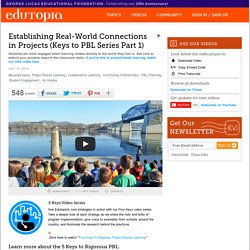
So students are given this question, for example, "What's in our water? And how did it get there? " And then the students choose different paths to explore that question. Sheela: Start to examine what's happening in your local community. What are some problems? Lisa: It's knowing people. Sheela: We find that the best way is to take the kids out into the community. Peggy: Once you're aware of this type of approach to teaching, it's like you have little antenna out. Building Rigorous Projects That Are Core to Learning (Keys to PBL Series Part 2) Steven: A lot of people think that Project Based Learning is fluff.
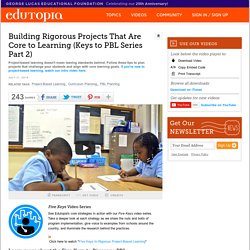
So what we did, instead of having a three-column rubric that has "Unsatisfactory, Proficient and Advanced," we added a fourth column. It is the "Standards," what has to be taught. Peggy: Students are going to address the content that they need to learn through this PBL approach. Structuring Collaboration for Student Success (Keys to PBL Series Part 3) Peggy: The teacher doesn’t just throw control to the students and say, "Let me know what you figure out.
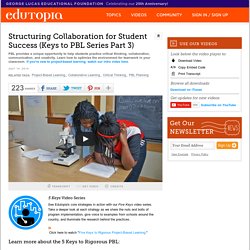
" She really has to plan ahead of time, she has to figure out how to group the students so that they're the most productive. She has to scaffold their work, so she provides hints or clues or templates, worksheets is necessary, to kinda show them what they need to do first, what they might consider doing next. She has to teach them how to work together. Teamwork is not something that comes naturally, especially for younger students. They really need to learn how to do that. Facilitating Learning in a Student-Driven Environment (Keys to PBL Series Part 4) Liza: So when you're working on projects and you really have student-driven lessons, it can be scary because you don't feel like you're in control, but you really are.
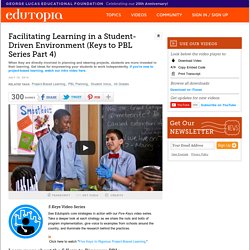
If you are planning the right way ahead of time, you are scaffolding every single aspect of that lesson and what the students are doing. You may say to yourself, it's way too much, there's too much to do. But that hard work in the beginning allows it to be completely student-driven and they know that this is their education and that I'm here to support them. Embedding Assessment Throughout the Project (Keys to PBL Series Part 5) Peggy: Different than a traditional classroom, PBL's gonna integrate assessment throughout the project.
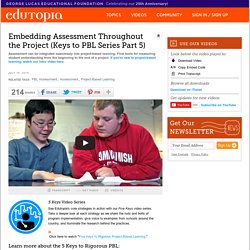
Because these projects are multi-week projects, you need to keep on top of students and build in opportunities to assess where they are and what they're learning as you go along. Sheela: From the minute a teacher introduces that learning target for the lesson, or engages in strategic observation, we feel that the assessment process is in play. La importancia del tiempo en el aula.
En una serie de artículos que he leído de Karl Fisch desgrana distintos aspectos que rodean a la educación y que influyen directamente o indirectamente en el éxito de los estudiantes y en la forma en la que el aprendizaje se “materializa” en sus vidas.
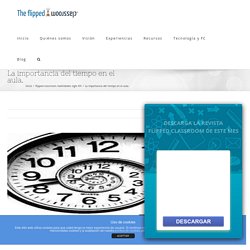
El autor cuestiona en su blog aspectos tan importantes como el curriculum, la comunicación de notas o resultados, la relación con las familias, la motivación, la organización del aula y, finalmente, la importancia de la gestión del tiempo en clase. Ha sido este punto el que más me ha interesado ya que viene a demostrar, una vez más, que el modelo flipped classroom defiende y aboga por la personalización del aprendizaje y convertir el aula en un espacio en el que los estudiantes puedan aprender no solo ellos mismos, sino también con compañeros y con el profesor.
Es, en definitiva, un modelo pedagógico más social, más inclusivo, más personal. Educando el pensamiento crítico ¿Y tú ya lo haces? #kitprofes - Inevery Crea. Close formatos disponibles Ir al contenido principal All the community You are in: Panel Information.
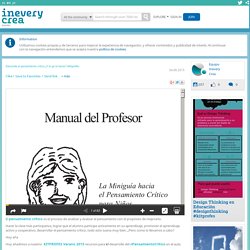
Repensar l'educació - UNESCO Cat. Estratègies d’avaluació per a la millora de l’ensenyament per proje… ¿Qué es el aprendizaje basado en competencias? – juandon. Innovación y conocimiento. Juandon El aprendizaje basado en competencias es un enfoque de la educación que se centra en la demostración de los resultados de aprendizaje deseados como el centro del proceso de aprendizaje del estudiante. Se refiere principalmente a la progresión del estudiante a través de planes de estudio a su propio ritmo, profundidad, etc. Como han demostrado las competencias, los estudiantes continúan progresando. L’aprenentatge cooperatiu: estratègies que funcionen.
El proper dijous, 9 de juny de 18.00h a 19.00h (GMT+1), us convidem a aquest nou webinar sobre l’aprenentatge cooperatiu.
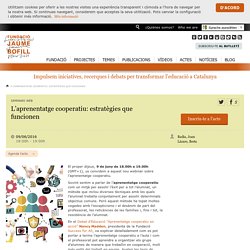
Sovint sentim a parlar de l’aprenentatge cooperatiu com un mitjà per assolir l’èxit per a tot l’alumnat, un mètode que inclou diverses tècniques amb les quals l’alumnat treballa conjuntament per assolir determinats objectius comuns. Però aquest mètode ha topat moltes vegades amb l’escepticisme i el desànim de part del professorat, les reticències de les famílies i, fins i tot, la resistència de l’alumnat. Entornos Personales de Aprendizaje: claves para el ecosistema educativo en red. Páginas: Codrops: Free Responsive Book Social icons Presentación El interés de los Entornos Personales de Aprendizaje (PLE, por sus siglas en inglés) no reside tanto en su novedad conceptual o tecnológica, como en la asunción de una perspectiva sobre la educación que intenta responder al gigantesco cambio tecnológico y cultural que ha tenido lugar en las últimas dos décadas en nuestra sociedad.
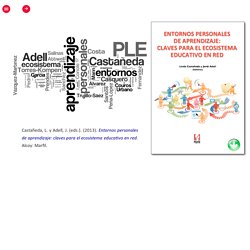
Desde nuestra perspectiva, el tema de los PLE es un nodo, y esperemos que un punto de inflexión, en el que confluyen el pensamiento, los debates y las prácticas sobre qué aprender y cómo aprender -y enseñar- a principios del siglo XXI. 157 AMBIENTS. AMBIENTS D'APRENENTATGE by Anna Rufat on Prezi. Presentació ambients claustre. Lletra lligada o lletra d'impremta? La caligrafía, un ejercicio educativo en cuestión. Las escuelas de Finlandia, referente educativo de Europa, dejarán de invertir tanto tiempo en escribir a mano.
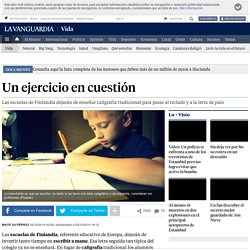
Esa letra seguida tan típica del colegio ya no se enseñará. En lugar de caligrafía tradicional los alumnos aprenderán a escribir en ordenador (teclado de tableta o portátil) y también a mano con letra de palo, separada. Esto sí será obligatorio. Lo de escribir con letra caligráfica pasará a ser sólo una opción, y los maestros no tendrán por qué enseñarlo. STEADY! - PROGRAMEM PELS MÉS PETITS. Investiguem a Educació Infantil i Cicle Inicial de Primària (Proposta 8 - Febrer 2015) Nuevas dinámicas para la biblioteca escolar en la sociedad red. Resituar sus acciones y acompañar la transformación de la escuela. Publicado en Agosto 28, 2014 por julio Durban Roca, G., J. I. Lara Escoz, et al. (2012). Pla de treball. Lletra lligada, sí? Lletra lligada, no? Imma Gómez-Pallarès i Xènia Riba, professores de Didàctica de la llengua dels graus d’Educació Infantil i de Primària.
Lletr a lligada? Cal·ligrafia? Lletra d’impremta? GOMA EVA, PEGAMENTO Y TIJERAS: RÚBRICA DE EVALUACIÓN. PROYECTO: ¡SOMOS PIRATAS! Envision Schools Project Exchange. In this project, students generated their own questions about the history of South Africa. These questions guided the activities and smaller projects leading up to the culminating exhibition, where students researched and presented their answer to their question in a powerpoint presentation. This project is interdisciplinary. Sample Project: Healthy Choices = Long Life! Educational Leadership:Giving Students Meaningful Work:Seven Essentials for Project-Based Learning. Complete Guide to Project-Based Learning.
Modern science continues to develop in such a way that the older generation is constantly trying to catch up with the younger generation’s adaptation to new developments and technologies. It is only logical that we should utilize our students’ familiarity with technology from a young age to maximize their engagement and learning by integrating it into our curriculum.
Project-Based Learning grabs hold of this idea and fosters deep learning and autonomy by using technology to help students engage in issues and questions relevant to their lives. Building a PBL Culture in the Classroom. During a project, what does a classroom look, sound, and feel like? I asked this question of three of BIE’s National Faculty members to begin a Google Hangout last week. Driving Questions. The Design Thinking School \ What we do. Design Thinking can be a powerful vehicle for deeper learning of content, more divergent thinking and building the thinking skills capacity of learners. Key to the process's success in learning, is that it provides the platform for learners to become problem finders. At a time when design thinking tends to come across as "shop" class and post-it notes, NoTosh have spent four years developing medium- and long-term professional development programmes with schools around the world, which marry design and education research with classroom practices that work in any part of curriculum.
We've seen schools increase student engagement, content coverage and attainment thanks to the challenging way we frame design thinking and formative assessment, together, as a vehicle for creative and robust learning. Conectivismo y aprendizaje en Red. Diego Leal Fonseca #IBERTIC. George Siemens - Conectivismo - Lima, 2012. 7 plataformas de gamificación. Más allá del palabro de moda, la gamification o gamificación es una técnica para incentivar determinados comportamientos mediante la aplicación de mecánicas de juego. Para conseguirlo, lo primero que hay que hacer es identificar los procesos o actividades que queremos incentivar (aumentar las ventas en un equipo comercial, mejorar la atención al cliente en un call center, disminuir el absentismo escolar…) y, después, aplicar las mecánicas de juego (niveles, insignias o badges, clasificaciones…) más adecuadas para aumentar la motivación intrínseca de nuestra audiencia objetiva.
Para ayudarnos con esa aplicación práctica existen una serie de plataformas de gamificación que, básicamente, monitorizan de forma automática y continuada los procesos gamificados e implementan las mecánicas de juego. La gamificación, una nueva forma de aprender. La gamificación es el uso del pensamiento y la mecánica de juego en contextos ajenos a ellos. ¿Es el aula un contexto ajeno al juego? ¿Se pueden introducir los juegos cuando son digitales? Innovación Educativa Aplicada - Gamificación - Comunidad - Google+ Trucos sencillos para implementar la gamificación.
Adrián Díaz-Caneja | Madrid 12 de Febrero de 2014. El potencial de la gamificación aplicado al ámbito educativo. La gamificación: algunas teorías sobre el proceso de motivación. 6 textos curados sobre ventajas y problemas de la gamificación. Cómo crear modelos de aprendizajes dinámicos usando Gamificación. La Gamificación puede mejorar significativamente el proceso de aprendizaje. Usando elementos característicos que juegan un papel importante en los juegos se puede crear un ambiente de aprendizaje mas dinámico donde los estudiantes pueden aprender mas fácilmente conceptos específicos. Salones Gamificados.
Gamificación del aprendizaje: una tendencia educativa - Curador: Hugo Martinengo. Según consta en el Informe Horizon para este 2014, en los próximos 2 años la gamificación será una tendencia metodológica que irá penetrando en las aulas. Gamificación: nueva arma de lucha contra el fracaso escolar - curador: H. Martinengo. Gamificacion. Gamificacion Potencialidades y Riesgos. Gamification spanish. "The Game of Life: Designing a Gamification System to Increase Current " by Ya Chiang Fu. Andres Eduardo Garcia: Revisando: La Gamificación (30/01/2012) Crítica y conciliación de la ludificación. Eduteka - La taxonomía de Bloom y sus actualizaciones.
LaFLor. Edu365.cat. Buenas PrácTICas 2.0. La Eduteca. Centros + Portales Educativos. Jenifer Fox: "Cada estudiante tiene una fortaleza" Enseñar a pensar: el aprendizaje del futuro. Paradigma del Sistema Educativo. Sant Lluís Gonçaga. ¿Cómo debemos educar a los 'nativos digitales'? Marc Prensky, inventor del término, responde : One – Vodafone.